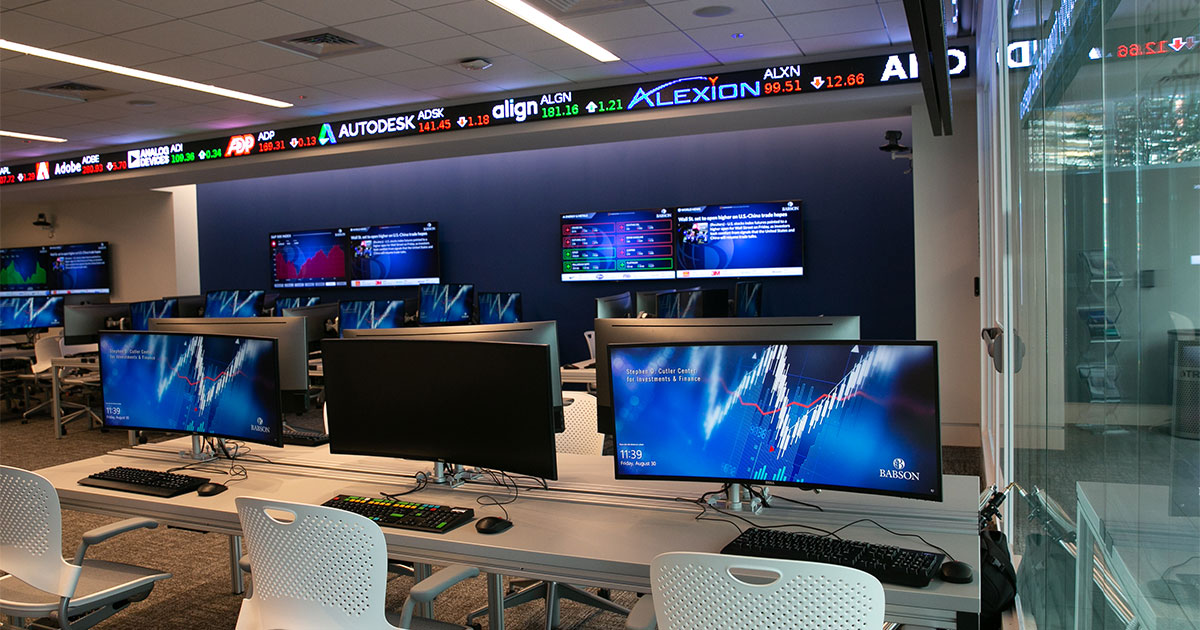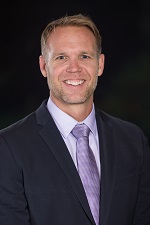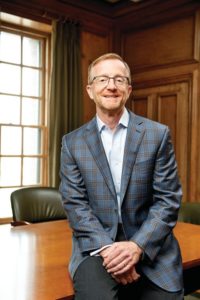Beyond Rate of Return: Babson Changes Investment Strategy

Spend time in Babson’s classes or with the College’s students and professors, and the values that define the community soon become apparent: sustainability, diversity, and the drive to make an impact on communities and the planet.
The College now wants to live up to these values in its investments as well.
In February, Babson’s Board of Trustees voted to integrate ESG (environmental, social, and governance) factors—a growing form of investing that essentially takes a broader view of a company beyond just its profitability—while making investment decisions for its endowment. The board voted to incorporate DEI (diversity, equity, and inclusion) principles into its endowment investing as well.
“We think this is the right time, and we think this is the right thing for Babson,” says Bruce Herring ’87, P’19, a Babson trustee and chair of the school’s investment committee, which led the College’s efforts in adopting ESG and DEI investing. “We believe this adoption is aligning the objectives of the endowment with the mission of the College.”
Babson President Stephen Spinelli Jr. MBA’92, PhD echoed that sentiment. “Babson’s mission is to empower entrepreneurial leaders to create lasting social and economic value,” Spinelli says, “and that entrepreneurial leadership needs to extend everywhere, including to the investments we make as an institution.”
LEARN MORE: On April 7, the Stephen D. Cutler Center for Investments and Finance and the Babson Finance Association are hosting Sustainable Investing Day. Sign up to attend three virtual panels looking at the latest trends and research in the growing movement of ESG (environmental, social, and governance) investing. Register now.
In terms of making a return on its investment, the endowment at Babson already has proven successful. In the past seven years, it has performed better than 98 percent of endowments of similar size. Just last year, the College’s portfolio, which has a total value of more than $500 million, realized a return of 14.1%.
With the vote by the trustees, however, the College is looking to earn more than just a great return. “Imbedded into ESG is the notion you can do well and do good,” Herring says. “It’s not just profit maximizing. It’s not just risk and return. It’s risk, return, and impact.”
A Fuller Portrait
Investing that takes a more socially responsible emphasis is not new, says Patrick Gregory, senior lecturer of finance and managing director of Babson’s Stephen D. Cutler Center for Investments and Finance. Some investors have chosen to exclude companies in specific sectors, such as tobacco, from their portfolio for many years.

Patrick Gregory, managing director of Babson’s Stephen D. Cutler Center for Investments and Finance
ESG investing, however, doesn’t simply exclude certain companies. Instead, it takes a fuller portrait of the risk and reward of potential investments. Beyond the usual profitability metrics, ESG investing also looks at environmental (how much carbon is the company emitting?), social (how does the company treat its workforce?), and governance (how transparent is the company?) factors.
“It’s a more rigorous form of a fundamental analysis because these factors are being explicitly integrated into the decision-making process,” Gregory says. “It gives us a more complete picture of a company’s future prospects. We want to make sure we allocate funds to companies that are doing well and doing good.”
For the College to also include DEI as well as ESG in its investment decisions is only natural, Gregory says. “I think of the two being tethered,” he says. “I think the two are inextricably linked.”
ESG investing has grown significantly over the last several years and now represents one-third of all U.S. assets, Gregory says. At first, there were worries about the returns that such socially focused investing would generate. “Ten years ago, there was a concern that you needed to sacrifice returns to invest this way,” Gregory says. “Those concerns have subsided. Many studies show that returns are on par with traditional approaches.”
“Imbedded into ESG is the notion you can do well and do good. It’s not just profit maximizing. It’s not just risk and return. It’s risk, return, and impact.”
Bruce Herring ’87, P’19
If anything, the more in-depth portrait of a company provided by ESG and DEI investing illuminates greater potential returns. “As with all forms of investing, the focus is on the risk-reward profile of the companies we allocate money to,” Gregory says. “But, by looking at companies through an ESG and DEI lens, you have a better chance of identifying opportunities and risks you may have missed using a traditional approach.”
Pressure on Corporations
So, how exactly does using ESG and DEI considerations in investing play out? Gregory offers some specific examples.
Consider eBay, which in recent years has made a significant commitment to having a more diverse board in terms of both race and gender. Such diversity is not only the right thing to do, but it also can mean a better operating performance. A more diverse board means more viewpoints and ideas.

Bruce Herring ’87, P’19, a Babson trustee and chair of the school’s investment committee
“If you see a company committed to racial and gender equality, that can be reflected in the financial forecast and the valuation you ascribe to that company,” Gregory says. “A more diverse workforce often leads to better business performance and, by extension, higher stock returns.”
Another smart investment choice might be Costco, which pays its workers significantly more than its competitors. Again, that’s not just the right thing to do. If the growing movement to raise the minimum wage finally succeeds, Costco will be in a much better position than its competitors, who will face increased labor costs. “It is not a risk to Costco,” Gregory says. “In that regard, Costco would be best in class.”
The Babson College Fund, which allows Babson students to manage a portion of the College’s endowment, has been actively integrating ESG in its investment decisions for the past year, says Gregory, the fund’s director. With the Board of Trustees’ decision, the rest of the endowment follows in its path.
The impact of ESG, however, is felt far beyond Babson, influencing how companies run their businesses. “Babson’s decision adds to the growing ESG movement,” Herring says, “which is encouraging companies to think more deeply about their people and their impact on the planet.”
Posted in Community




